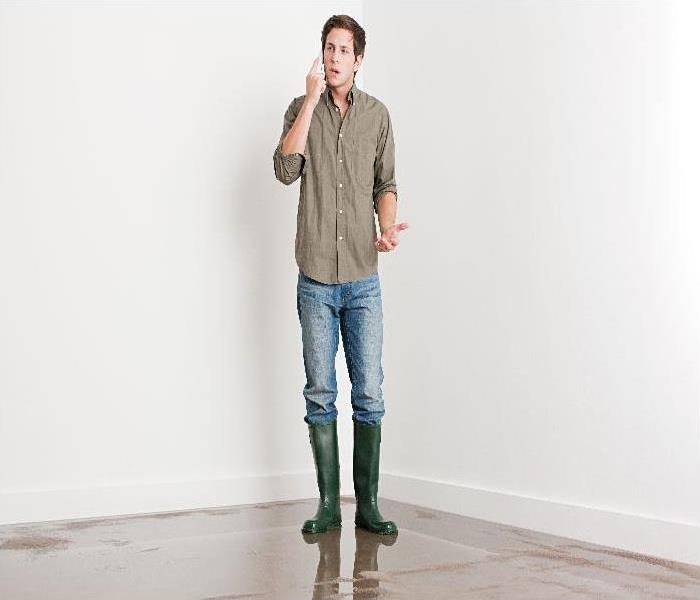How Do I Clean Up My Bronx Basement Apartment After a Flood?
4/28/2020 (Permalink)
Our SERVPRO Professionals Have Efficient Drying and Potent Cleaning Approaches to Make Your Bronx Apartment Feel Like Home Again After a Flood
Flooding can damage a house in many ways, but apartments can often get even worse damages. Without higher square footage that you might find in single-family homes, basement apartments common to the area can experience several feet of standing water in severe circumstances. This disaster threatens the entire layout of your apartment, its contents, and any of its occupants. Our SERVPRO professionals can help with a fast and confident response that showcases the full measure of our cutting-edge equipment to make flood losses “Like it never even happened.”
How Do I Get Rid of Standing Water?
Addressing flood damage in your Bronx apartment involves knowing what your residence needs as soon as our team arrives. With almost all flood scenarios, some degree of extraction and water removal is necessary. We have multiple extraction units that can help to resolve this need as quickly as possible so that vital drying efforts can begin. Some of the most heavily used of our water removal tools are:
Submersible Pumps
One of the advantages of using submersible pumps is that the motor and all of the working elements that provide the suction and response of the device are protected from water. The entire unit can get submerged entirely and reduce standing water down to two inches in depth.
Truck-Mount Pumps
Our SERVPRO Green Fleet features extractor trucks with mounted pumps driven by the engine of the vehicle. An advantage of using this variety of extractor for standing water in the house is that the intake can get submerged, and water gets forcefully drawn from the damaged area at a 300-psi rate. It is the most powerful extractor in our inventory.
Wet Vacuums
Vacuums are among the most versatile extraction tools that our team can use. Not only can these portable units reach inaccessible areas in the farthest reaches of your basement apartment, but it is also a foundation for many helpful attachments like a carpet wand or squeegee wands for specific flooring types.
Are Debris and Contaminants Likely a Problem After Flooding?
Because of the position of your basement apartment to the main street level here in the city, flooding in the neighborhood can bring many different substances and debris into your home. It is ideal to manage this buildup and any present solids or residues as soon as possible when extraction completes. Some of the most common threats and contaminants that your apartment faces during natural flooding include:
Oils
Heavily traveled roadways are magnets for all manner of fluids used to keep cars running well. Oils, grease, fluids, and other chemical substances can all get carried into your apartment with floodwater. This presence can leave a challenging film on contents and surfaces that requires water-based solvents to address.
Foliage and Mud
If water passes through dirt and landscape features that might be in front of the apartment building or along the street, it can also bring this sediment into your unit. Dry vacuuming and muck-out shoveling can be useful in removing this buildup on the floors.
Cinders and Grit
With nearly constant traffic moving up and down the street in front of your building, gravel, cinders, and road grit, all can build up along the edges of the roadway. When flooding occurs, this is light enough to get moved and carried to your apartment quickly.
What Tools Get Used in the Drying of My Apartment?
When it comes to drying your residence after a flood, there are multiple tools that our team can use. Each of these listed items has a significant role in the recovery of your apartment depending on different materials used, changing conditions in the environment, and other relative drying sciences. Some of the most efficient moisture removal tools that our SERVPRO team uses are:
Air Movers
There are multiple styles and types, but these units are responsible for directing heated airflow throughout the damaged apartment. This continual circulation of air can be a useful evaporative tool.
Dehumidifiers
Regulating the moisture in the environment is a critical element of efficient drying of your apartment after a flood. Desiccant dehumidifiers help to remove higher concentrations of moisture and exhaust heated, dry air back into the unit.
Electric Portable Heaters
Increasing the temperature in established drying zones can help to keep cool air pockets from forming that can slow the progress of drying efforts.
Positive Pressure Systems
Structural cavities can be a pathway for flood damage to move from one damaged unit to another. If it gets determined that drywall and other structural elements do not need to get removed, positive pressure systems can help to evaporate moisture pockets trapped in this cavity before secondary effects like mold growth can take root.
Is Professional Cleaning Necessary After Flooding?
Cleaning has always been one of the staple phases of flood recovery for our professional restorers, and it is a recommended process versus DIY approaches. Because your basement apartment is a condensed space, inadequate cleaning can lead to widespread odors or microbial threats that envelop the entire unit.
After a flood, it is vital to begin restoration immediately. Give our SERVPRO of South Bronx team a call at (347) 590-9902.
For more about The Bronx click here.






 24/7 Emergency Service
24/7 Emergency Service
